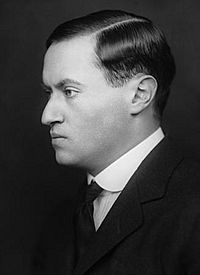Lewis Namier facts for kids
Sir Lewis Bernstein Namier (born Ludwik Bernstein Niemirowski; 27 June 1888 – 19 August 1960) was a famous British historian. He was born in Poland, which was then controlled by Russia, and later became a British citizen.
Namier is best known for his important books about British politics. These include The Structure of Politics at the Accession of George III (1929) and England in the Age of the American Revolution (1930). He also helped edit the History of Parliament series.
About His Life
Lewis Namier was born in a place called Wola Okrzejska in Poland. His family moved to another part of Poland that was controlled by Austria in 1890. His family was Polish-Jewish gentry, which means they were from a noble background.
He studied at universities in Lwów (now in Ukraine) and Lausanne before moving to the United Kingdom in 1907. He studied at the London School of Economics and Oxford University. In 1913, he became a British citizen and changed his name to Lewis Bernstein Namier.
During World War I, he served in the army for a short time but was discharged because of poor eyesight. After that, he worked for different government departments that dealt with information and foreign affairs.
His Career
After World War I, Namier was part of the British team at the Versailles Peace Conference in 1919. This conference helped decide what would happen after the war. He was very interested in Russian affairs.
Later, Namier worked as a political secretary for the Jewish Agency in Palestine from 1929 to 1931. He was a strong supporter of Zionism, which is the movement to create and support a Jewish homeland. He worked to help Jewish refugees from Germany starting in 1933.
From 1931 until he retired in 1953, Namier was a professor at the University of Manchester. He was very popular with his students. In 1952, he was knighted, which means he received the title "Sir" from the King or Queen.
His Family
In 1917, Namier married Clara Sophia Edeleff-Poniatowska, but they separated a few years later.
In 1947, after his first wife passed away, he married a writer named Julia de Beausobre. She later wrote a book about his life. To marry Julia, who was a Christian, he converted to Anglicanism.
His Ideas About Politics
Namier is most famous for his studies of the Parliament of Great Britain, especially how English politics worked in the 1760s. He looked closely at individual Members of Parliament (MPs) and noblemen.
He used a special method called prosopography. This means he studied the lives of many people in a group to understand how they behaved. He found that local interests often influenced how politicians voted, not just big national ideas.
Namier believed that political groups like the Tories and Whigs were not always tightly organized. Instead, he thought they were made up of smaller groups that changed their views depending on the issue. His work changed how historians understood the 18th century.
He also thought that people's deep feelings and personal drives played a big part in politics.
His Books
- The House of Commons, 1754–1790 (3 vols.), 1966 (edited with John Brooke)
- Crossroads of Power: Essays on Eighteenth-Century England, 1962
- Charles Townshend, His Character and Career, 1959
- Vanished Supremacies: Essays on European History, 1812–1918, 1958
- Personalities and Powers, 1955
- Basic Factors in Nineteenth-Century European History, 1953
- Monarchy and the Party System, 1952
- In the Nazi Era, 1952
- Avenues of History, 1952
- Europe in Decay: A Study in Disintegration, 1936–1940, 1950
- Diplomatic Prelude, 1938–1939, 1948
- Facing East: Essays on Germany, the Balkans and Russia in the Twentieth Century, 1947
- 1848: The Revolution of the Intellectuals, 1944
- Conflicts: Studies in Contemporary History, 1942
- In the Margin of History, 1939
- Skyscrapers and other Essays, 1931
- England in the Age of the American Revolution, 1930
- The Structure of Politics at the Accession of George III, 1929
See also
 In Spanish: Lewis Bernstein Namier para niños
In Spanish: Lewis Bernstein Namier para niños


